This is the first part of a series of articles looking into the various hidden treasures that exist throughout Ulaanbaatar. This weeks article will focus on the beauty of the 40K and 50K buildings.
Ulaanbaatar is a city that has both been blessed and scarred by its past. The People’s Revolution of 1921 was the true beginning of modern architecture and urban planning in UB, marking the beginning of the modern city’s life. According to N. Natsagdorj’s brilliant Construction History of Ulaanbaatar City before the revolution there were no local construction companies or qualified local workers within the city. Following the revolution though the establishment’s aim would be to develop the capital city and then develop an overall action plan to be implemented in different stages. There would be a number of key buildings created but it would not be until after World War Two that the people of Ulaanbaatar would truly have the opportunity to build their city into the modern socialist capital we have a glimpse of today.
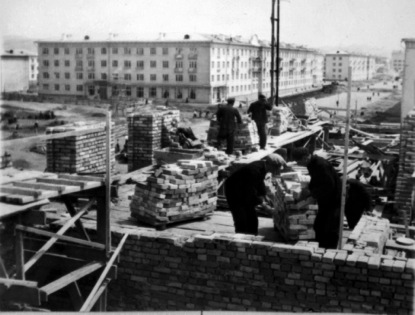
It would be this post war urban expansion that would lead to the creation of Mongolia’s major social and economic hub, Ulaanbaatar, which would in time become the canvas for many Soviet artists and architects. Between 1954 and 1961, during the implementation of the First master plan, the residential buildings that are the 1st and 2nd 40,000 and the 50,000 districts were created; all proposed households being laid out in a carefully organized manner around the administrative center Sukhbaatar Square - now known as Chinggis Square. The city’s initial plans were based upon a population of 130,000 people quite amazing when contrasted with the current population, according to the Statistics Department of Ulaanbaatar the population now stands at 1,372,000 people; over 10 times higher in just 60 years.
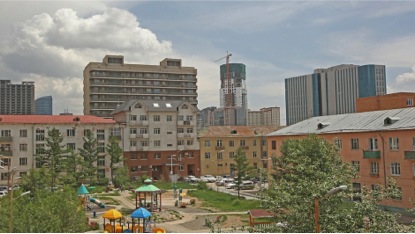
The 40,000 and 50,000 buildings themselves were created with quality of life in mind with each building making up the side of a greater courtyard. For those lucky enough to live in one of the buildings that still retains green space it really helps to create a softer feeling to life in the city center. When one looks at photographs of UB in the past it looked like a civic oasis with wide tree lined boulevards and leafy courtyards. This greenery is something that will hopefully survive into the future, at very least in some areas of the city as central public space dwindles. Nature in urban centers is very important for a range of things including health, sustainability, and overall happiness. All of these are areas would have directly been improved because of the good urban design that went into the creation of the soviet 40,000 and 50,000 buildings. Good urban design and planning is possibly something that will need more focus in the future if citizens of UB are to truly prosper.
From an aesthetic standpoint the 40,000 and 50,000 buildings are highly attractive combining simple lines that would make Le Corbusier proud with classical plasterwork of Mongolian patterns lining the tops of buildings. This juxtaposition has lead to the creation of sumptuous buildings that have stood the test of time. On a more basic level one can admire the pallet of materials used when creating these buildings. The warm hews of orange, terracotta and a dirty cream makes for a charming appearance when mixed with the stark bright green or newer metallic corrugated metal roofs. In sum this has led to the creation of a very unique appearance and atmosphere in the down town area of UB.
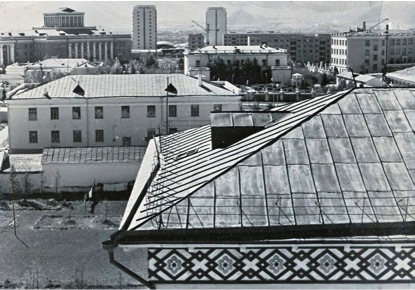
Heritage is something else that must be considered when looking at these buildings and how the 40,000 and 50,000 apartments are a valuable feature of the Mongolian cityscape. The structures tell stories about the people that once lived here and will help residents of the future find their identity. Talking with residents that once lived in these places one can find intriguing and inspiring fragments of the past, hearing about a friend’s teacher that lived in one 40K or a childhood spent in another. It is such buildings that have meaning and will in the future bring a sense of place to this city; giving definition to what it is to be from Ulaanbaatar.
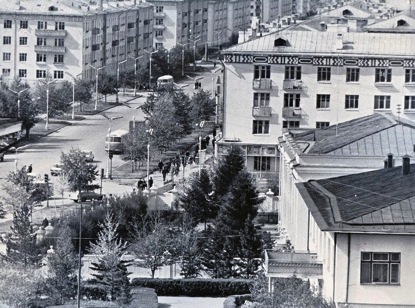
At present these magnificent buildings are under threat with the Municipality of Ulaanbaatar talking about demolishing this part of UB’s physical past with an aim of creating a new phase of the city’s development. These are decisions that must not be taken without careful consideration of their greater consequences. All of the great cities of the world have protected and retained large parts of their heritage in order to preserve their past and their story. Examples of such cities are far and wide including London, Tokyo and Paris all of which are renowned for being world-class destinations to live and travel to. The destruction of this stage of UB’s historic fabric may cause much more damage than good.
The future of these apartment buildings may be at risk but there is hope to be found in the work of both private individuals and companies that are investing heavily in the great potential of the 40K and 50K buildings. Such work being done can unlock great economic and social value. Improving simple things like renovating communal staircases can completely transform the atmosphere of a community and directly increase the capital value of a property. One can only hope such projects pay off in making wider UB society see the value in preserving these buildings into the future.
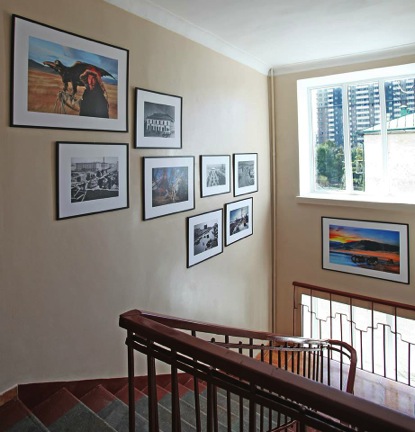
This is the first part of a series of articles looking into the various hidden treasures that exist throughout Ulaanbaatar. This weeks article will focus on the beauty of the 40K and 50K buildings.
Ulaanbaatar is a city that has both been blessed and scarred by its past. The People’s Revolution of 1921 was the true beginning of modern architecture and urban planning in UB, marking the beginning of the modern city’s life. According to N. Natsagdorj’s brilliant Construction History of Ulaanbaatar City before the revolution there were no local construction companies or qualified local workers within the city. Following the revolution though the establishment’s aim would be to develop the capital city and then develop an overall action plan to be implemented in different stages. There would be a number of key buildings created but it would not be until after World War Two that the people of Ulaanbaatar would truly have the opportunity to build their city into the modern socialist capital we have a glimpse of today.

It would be this post war urban expansion that would lead to the creation of Mongolia’s major social and economic hub, Ulaanbaatar, which would in time become the canvas for many Soviet artists and architects. Between 1954 and 1961, during the implementation of the First master plan, the residential buildings that are the 1st and 2nd 40,000 and the 50,000 districts were created; all proposed households being laid out in a carefully organized manner around the administrative center Sukhbaatar Square - now known as Chinggis Square. The city’s initial plans were based upon a population of 130,000 people quite amazing when contrasted with the current population, according to the Statistics Department of Ulaanbaatar the population now stands at 1,372,000 people; over 10 times higher in just 60 years.

The 40,000 and 50,000 buildings themselves were created with quality of life in mind with each building making up the side of a greater courtyard. For those lucky enough to live in one of the buildings that still retains green space it really helps to create a softer feeling to life in the city center. When one looks at photographs of UB in the past it looked like a civic oasis with wide tree lined boulevards and leafy courtyards. This greenery is something that will hopefully survive into the future, at very least in some areas of the city as central public space dwindles. Nature in urban centers is very important for a range of things including health, sustainability, and overall happiness. All of these are areas would have directly been improved because of the good urban design that went into the creation of the soviet 40,000 and 50,000 buildings. Good urban design and planning is possibly something that will need more focus in the future if citizens of UB are to truly prosper.
From an aesthetic standpoint the 40,000 and 50,000 buildings are highly attractive combining simple lines that would make Le Corbusier proud with classical plasterwork of Mongolian patterns lining the tops of buildings. This juxtaposition has lead to the creation of sumptuous buildings that have stood the test of time. On a more basic level one can admire the pallet of materials used when creating these buildings. The warm hews of orange, terracotta and a dirty cream makes for a charming appearance when mixed with the stark bright green or newer metallic corrugated metal roofs. In sum this has led to the creation of a very unique appearance and atmosphere in the down town area of UB.

Heritage is something else that must be considered when looking at these buildings and how the 40,000 and 50,000 apartments are a valuable feature of the Mongolian cityscape. The structures tell stories about the people that once lived here and will help residents of the future find their identity. Talking with residents that once lived in these places one can find intriguing and inspiring fragments of the past, hearing about a friend’s teacher that lived in one 40K or a childhood spent in another. It is such buildings that have meaning and will in the future bring a sense of place to this city; giving definition to what it is to be from Ulaanbaatar.

At present these magnificent buildings are under threat with the Municipality of Ulaanbaatar talking about demolishing this part of UB’s physical past with an aim of creating a new phase of the city’s development. These are decisions that must not be taken without careful consideration of their greater consequences. All of the great cities of the world have protected and retained large parts of their heritage in order to preserve their past and their story. Examples of such cities are far and wide including London, Tokyo and Paris all of which are renowned for being world-class destinations to live and travel to. The destruction of this stage of UB’s historic fabric may cause much more damage than good.
The future of these apartment buildings may be at risk but there is hope to be found in the work of both private individuals and companies that are investing heavily in the great potential of the 40K and 50K buildings. Such work being done can unlock great economic and social value. Improving simple things like renovating communal staircases can completely transform the atmosphere of a community and directly increase the capital value of a property. One can only hope such projects pay off in making wider UB society see the value in preserving these buildings into the future.

